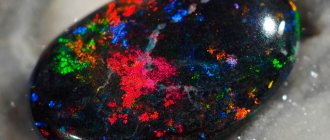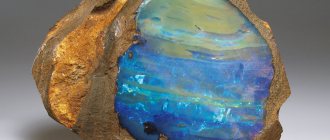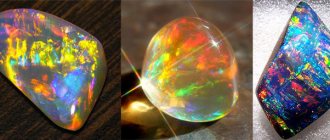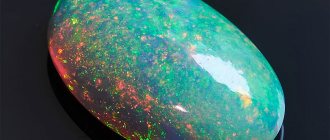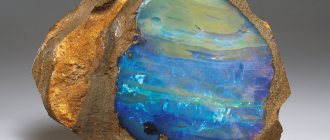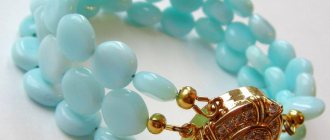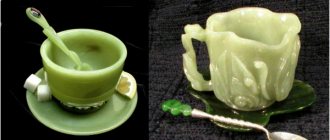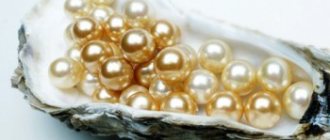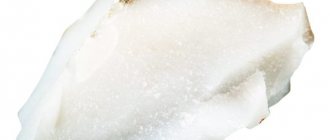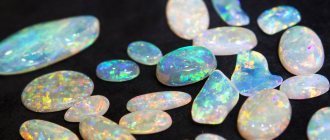Nature is the best creator and designer. She forms her masterpieces over thousands of years, patiently polishing her skills. A person can only enjoy the amazing creations of her hands. Stones are such delightful works. Precious and semi-precious, they have long been used for inlaying jewelry, decorating royal palaces and houses of worship. Jewelry with opals was highly valued and not everyone could afford it. According to legend, gems are the frozen tears of Zeus’s joy after defeating the Titans.
His Majesty opal
Jewelry experts call opal a stone that consists of a hydrogel of silicon dioxide and water (no more than ten percent). It is especially valued because of its diversity, as it can have more than a hundred shades. The most common colors: red, green, blue, purple, yellow, blue, pink. During formation, the stone may contain inclusions of other minerals that make it unique. In addition, particles of manganese, iron, nickel or other elements determine the name of the opal variety.
The play of light, opalescence, is another advantage of this stone. It can be zonal, continuous or dotted, the surface can be heterogeneous and uneven. For this, designers with whimsical imagination adore him. The best shape for opal, which is also called “crack” because of its fragility, is a cabochon.
Dark colors of opal mineralites
There are main color groups of opals, which can be divided into dark and light. Dark stones include:
- Green opal. In appearance it can be confused with jade. It is often called a cat's eye for its bright iridescent color. It is believed that this similarity gives the pebble the ability to recognize deception and hypocrisy.
- Blue opal. In terms of depth and richness of color, it resembles the depths of the sea. As a rule, specimens that end up on the jewelry market are mined in Peru. The translucent blue mass with star-shaped inclusions looks more than impressive.
- Blue opal. It is also called differently as jirasol, and is mined mainly in Mexico, Brazil, Honduras and the Czech Republic. Despite its sky blue color, it is called the sun stone. The reason for this is the pronounced phenomenon of opalescence that it exhibits in the light. Passing through the almost white opal, the beam is subject to diffraction and demonstrates the optical illusion of a sharp increase in the phenomenon of light scattering. At the same time, it begins to play with solar-fiery glare.
- Boulder. This is a stone with a high iron content and therefore has brownish tints. It is classified as black opal.
Gemstone deposits
About 95 percent of opal production comes from Australia. There are also minor deposits of the mineral in Sudan, Brazil, the Czech Republic, Peru, and Mexico. In England, mines with black or royal stones are mined. Not long ago, a large deposit of a gem with special characteristics was discovered in Ethiopia.
New Ethiopian opals appeared on the market in 2008. The deposit, called Wegel Tena, is two hundred kilometers away from Mezezo, a long-known and almost depleted vein. Addis Ababa is more than half a thousand kilometers away. This region is formed by volcanic basalt, rhyolite calderas and sedimentary rocks. The layer of mineralized opal is quite thin, so it is mined using hand work, a hammer and a shovel. But the exact reserves of the noble gem have not yet been assessed.
Ethiopian opal and its features
New opals from the Dark Continent are usually white or yellow. Of course, there are stones of a rather dark shade - brown, almost black. Their distinctive feature is exceptional hardness and resistance to mechanical damage. Thanks to these qualities, the mineral almost does not crack during mining and processing. This is why the price of Ethiopian opal is quite high. A natural stone weighing 0.75 carats can be purchased for 1,500–2,000 rubles.
Stones from Wegel Tena are porous, which gives room for imagination. For example, if you soak them in water for a long time, they will lose the play of light and become transparent. After a few days, when the Ethiopian opal is completely dry, its structure and previous characteristics are completely restored.
The unusual designs and color play effects of these precious stones are also exceptional. Today you can find natural Ethiopian opal, colored by nature to resemble the skin of a lizard or snake. It should be noted that previously only artificial minerals created in the laboratory could have this color. Therefore, only high-level specialists can distinguish a fake from a truly noble stone.
How to distinguish an original from a fake
Wax opal ring
The presence of synthetic analogues, and even ordinary low-grade glass fakes on the market, encourages those who want to purchase a natural gem to look for effective ways to distinguish imitations from the original “without leaving the checkout.” There is such an opportunity - you need:
- Assess the nature of opalescence of the sample presented on the display case. In natural opals, flashes seem to appear out of nowhere and disappear there; they are chaotic and dynamic. In fakes, colored inclusions, as a rule, are motionless or appear in a strictly repeating sequence, even when viewing the stone from different angles.
- Only a “miracle of nature” is capable of casting a rainbow spectrum onto the hand when exposed to the sun’s rays.
- Synthetics have a rough (“scaly”) structure and noticeable air bubbles in it.
- Artificial gems stick to the tongue, while natural gems change color in tinted water.
- Doublets and triplets, upon careful examination, reveal seams on the surface where the layers are glued together.
- The color of natural opals is never uniform; there are always differences in tones, lighter or darker zones. The fakes are uniform in color.
Marketing Tricks
There are a large number of fans of noble stones. To enjoy its natural beauty, you should take proper care of it for a very long time. When choosing natural Ethiopian opal, the photo of which captivated you at first sight, you should remember that the play of color may differ in reality from the picture. In addition, the apparent visual effect largely depends on the viewing angle and lighting. Therefore, be prepared that the ordered stone may differ from the image displayed in the online store window.
Today on sale you can find stone impregnated with colorless natural oil (often used for Australian opals). This procedure enhances the play of color and fixes it. But over time, even the oil evaporates, so the decoration loses its beauty. You can help him at home by having on hand a pressure cooker with a hermetically sealed lid and any natural oil (preferably hemp or cedar).
Recommendations from astrologers
Opal goes well with almost all zodiac signs, but Ethiopian opal suits Libra best. The mineral will give representatives of this sign the confidence and courage necessary for prosperity, and will teach them to make the right decisions and solve complex problems.
Ethiopian opal will help the rest of the zodiac signs to become better people, get rid of uncontrollable anger and fear, and teach them to be purposeful and calm.
Charms, jewelry and talismans with opal are recommended for creative individuals. Artists, painters and writers will be able to draw inspiration and motivation for development from the stone.
Subtleties of care
It is better to store jewelry made from noble minerals in a closed box, where constant temperature and humidity are maintained. Do not expose them to overheating or hypothermia, drying out, or exposure to direct sunlight. If such a problem occurs, you can soak the Ethiopian opal in clean (optimally distilled) water for a day at room temperature and dry it under the same conditions. If the upper layers did not have time to collapse due to low (high) temperature or chemical exposure, then the play of color will be completely restored.
Magical properties of the mineral
Throughout its long history, humanity has had an ambivalent attitude towards opal. They admired and feared it, they were wary of it and adorned themselves with it. Alchemists considered it a very powerful stone; in the Middle Ages it was used for magical purposes and was called the “eye of evil.” It was believed that only people born under the constellation Scorpio could cope with the power of this mineral, so only they were allowed to wear it on the index finger of their right hand. If the opal is inserted into a gold frame, then its magical properties are doubled.
A white stone is ambiguous. It is a symbol of whims and betrayals; it can give rise to illusions and deceptive hopes. But at the same time, it influences the growth of spirituality, warns of dangers, awakens the gift of clairvoyance and prophecy, and creates harmony in life. But such an opal also enhances a person’s qualities, both positive and negative.
Opal in medicine
Since ancient times, man has used the gifts of nature in medicine, so opal was no exception. Indian doctors treated him with special respect. It was used to treat digestive system and respiratory tract infections, skin diseases and in gynecology. The stone helps fight stress and insomnia, rickets, and normalizes the condition of children with developmental delays. In the Middle Ages, they believed that if you look at the play of the color of the mineral every day, your vision will be restored. They also protected themselves from the plague. Modern science claims that opal really has a beneficial effect on the functioning of the nervous system and brain, and improves immunity.
Areas of application
Fine and some common opals are used by jewelers.
Diatomite is a rock that consists mainly of opal. It is used in the chemical industry.
Diatomite
Some interesting facts
Rainbow gems are used by jewelers all over the world. Ethiopian opal, as well as stones from other continents, is set in gold and silver frames. It is used in pendants, rings, earrings, and there are cases when it adorned royal tiaras. Interestingly, black and opaque opals have the greatest value, followed by milky white stones.
The Australian Museum (Sydney), the Natural History Museum (Vienna), and the Smeaton Institute (Washington) house the most famous opals in the world. For example, this includes the Roebling opal, the fire opal from the Hope collection; black opal "Devonshire" weighing one hundred carats; Nuling Nera stone (from the Goddard collection); "Red Admiral" with a butterfly design; a huge mineral “Australian Olympics” and “Fire Queen” with a red spot (the opal itself is enclosed in a green ring).
Divine or demonic?
Varieties of opal had different meanings among different peoples, but they all agreed on one thing: the stone is beautiful.
In China and India, rainbow opal extended its magical properties to love and friendship, and, for example, in Ireland it was identified with the warlike goddess of death, Macha, or Morrigan.
The Roman ruler Constantine never parted with a tiara crowned with an orphanus opal, believing that the lunar opal was the protector of his imperial honor. And in medieval Europe, torn by superstitions, all types of stone for a long time signified damage and disease.
At the dawn of the Middle Ages, adherents of magic called it the eye of the Devil.
The Spanish plague epidemic in the 16th century was officially recognized as being caused by this stone. Black opal was blamed by the Inquisition for the death of the royal son.
These precious stones were considered the causes of divorce, illness, war, and suicide. They even claimed that the stone contained a poisonous core that could kill its owner.
When Napoleon was sent into exile, the legendary Burning Troy cabochon disappeared from his treasury without a trace. Rumors immediately spread that the stone did not survive separation from its owner and destroyed itself.
